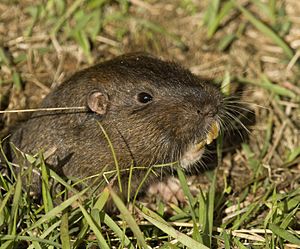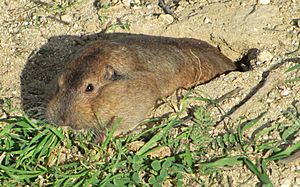Botta's pocket gopher facts for kids
Quick facts for kids Botta's pocket gopher |
|
|---|---|
 |
|
| Conservation status | |
| Scientific classification | |
| Genus: |
Thomomys
|
| Species: |
bottae
|
 |
|
| Botta's pocket gopher range | |
The Botta's pocket gopher (Thomomys bottae) is a small pocket gopher that lives in western North America. You might also hear it called the valley pocket gopher, especially in California. This gopher is named after Paul-Émile Botta, a scientist who studied animals in California a long time ago, in 1827 and 1828.
Contents
What Does It Look Like?
Botta's pocket gopher is a medium-sized gopher. Adults usually grow to be about 18 to 27 centimeters (7 to 11 inches) long. This includes their tail, which is about 5 to 6 centimeters (2 to 2.4 inches) long.
Male gophers are bigger than females. Males weigh about 160 to 250 grams (5.6 to 8.8 ounces), while females weigh 120 to 200 grams (4.2 to 7 ounces). Scientists think that male gophers might keep growing throughout their lives.
Their fur color can be very different from one gopher to another. It can even change during the year when they shed their fur. Some gophers have been seen with white fur (called albino) or very dark fur (called melanistic). Botta's gophers usually don't have a black stripe down their back. This helps tell them apart from their close relatives, the southern pocket gopher, if they live in the same area.
Where Do They Live?
Botta's pocket gophers are found from California all the way east to Texas. They also live from Utah and southern Colorado down into Mexico.
These gophers can live in many different places. This includes forests, scrublands, and even farms. They usually avoid very rocky areas, empty deserts, and big rivers. You can find them living high up in the mountains, sometimes as high as 4,200 meters (13,800 feet)! Scientists have found bones of Botta's pocket gophers in Oklahoma that are 31,000 years old.
There are about 195 different types, or subspecies, of Botta's pocket gophers. Most of these are named based on where they live. For example, many subspecies are found in California, Arizona, and Nevada.
What Do They Eat and How Do They Live?
Botta's pocket gophers are herbivores, which means they only eat plants. They especially like to eat young shoots and grasses. In winter, they also eat roots, tubers (like potatoes), and bulbs. A gopher will often pull plants into its burrow by the roots to eat them safely underground. They spend about 90% of their lives in their burrows.
Digging tunnels takes a lot of energy for these gophers. It can take hundreds or even thousands of times more energy to dig than to move on the surface, depending on how hard the soil is. Because digging is so hard, Botta's pocket gophers are good at saving energy. They have a low body temperature and don't use much energy when they are resting.
Many animals hunt Botta's pocket gophers. Some of their main predators are American badgers, coyotes, long-tailed weasels, and snakes. Other animals like skunks, owls, bobcats, and hawks also hunt them.
Sometimes, people see these gophers as a problem in cities and on farms because their digging can damage crops like alfalfa. However, their digging is also very helpful! Their tunnels help air get into the soil, which is good for plants. They can dig tunnels that aerate the soil up to 20 centimeters (8 inches) deep. Their digging can even create small hills called Mima mounds, which can be up to 2 meters (6.6 feet) tall. Scientists estimate that gophers can move as much as 28 tons of soil per hectare (about 2.5 acres) each year!
How Do They Behave?
Botta's pocket gophers are very good at adapting to different types of soil. They can dig in loose sand, hard clay, dry deserts, and even high mountain meadows. They can do this because they mostly dig with their strong teeth. Their teeth are larger and have thicker tooth enamel than gophers that dig mainly with their claws. Gophers that use their claws can usually only dig in softer soils because their claws wear down too quickly in hard ground.
These gophers are active for about nine hours each day. They spend most of this time eating in their burrows. They are not picky about whether it's day or night. They don't make much noise, but they do communicate with clicks, soft hisses, and squeaks.
Their burrows have several deep rooms for sleeping, storing food, and going to the bathroom. These rooms can be as deep as 1.6 meters (5 feet) underground. They also have tunnels closer to the surface where they find plant roots to eat. Shorter tunnels are used to push out the dirt they dig up. On the surface, you can spot their burrows by the fan-shaped piles of dirt. The entrance to the burrow is usually kept filled in to protect them.
Outside of the time when they have babies, each burrow is home to only one adult gopher. Young gophers leave the burrow once they are old enough to live on their own. Male gophers have larger burrow areas than females. Both males and females will strongly defend their burrow and the area around its entrance from other gophers.
How Do They Have Babies?
In places where there is a lot of food, like on farms, Botta's pocket gophers can have babies all year round. They can have up to four groups of babies (litters) each year. In colder or harsher places, they usually only have babies in the spring.
Female gophers can start having babies when they are very young, sometimes in the same season they were born. Males usually wait until they are 6 to 8 months old, or until the next breeding season.
A mother gopher is pregnant for about 18 days. She then gives birth to a litter of up to 12 babies, but usually, it's more like three or four. When they are born, the babies are hairless and blind. They are only about 5 centimeters (2 inches) long. They first grow a soft, silky fur coat, which is later replaced by a coarser grey coat. Finally, they grow their full adult fur.
Botta's pocket gophers can sometimes have babies with southern pocket gophers. For a long time, scientists thought they were the same species. However, if a male Botta's gopher and a female southern gopher have babies, the male babies cannot have their own babies. Female babies from this mix also have trouble having babies. This is why scientists now know they are different species.
See also
 In Spanish: Gofer de bolsillo de Botta para niños
In Spanish: Gofer de bolsillo de Botta para niños




